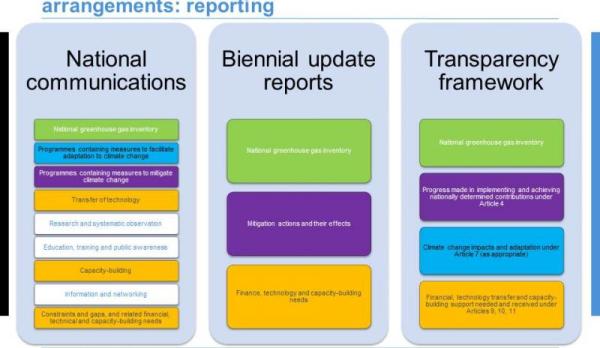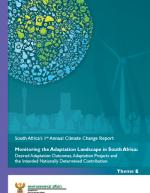Preparing for the new transparency framework – lessons learned, challenges, next steps
Many government representatives and climate experts consider the transparency framework to be the backbone of the Paris Agreement. In other words, they see it as the central mechanism for ramping up the ambition of the Nationally Determined Contributions (NDCS) and thus ultimately achieving the Agreement’s temperature target. However, the details of how the mechanism will work are still unclear: While the climate negotiators were meeting in Bonn for talks to work out the details of the modalities, procedures and guidelines (MPGs) of the enhanced transparency framework (ETF), governments worldwide are already thinking about how they can prepare for the Paris Agreement’s ETF and build on existing processes. A number of initial pointers have been drawn up during a series of events over the last few months, including the Technical Workshop on the Capacity Building Initiative for Transparency (CBIT), the International BUR Champions Workshop organised by the Partnership on Transparency in the Paris Agreement, and the Global NDC Conference, jointly organised by the United Nations Development Programme, the LEDS Global Partnership, and the Deutsche Gesellschaft für Internationale Zusammenarbeit (GIZ) GmbH.
Measurement, reporting and verification (MRV) and the transparency framework – a comparison
A comparison of the existing MRV regulations, as agreed at the climate negotiations in Bali in 2007 (COP 13) and Durban 2011 (COP 17), with the resolutions on the transparency framework within the Paris Agreement reveals that they share many similar elements and that countries can therefore clearly build on existing reporting processes (see Figure 1). Under the ETF, countries will in future have to report on four elements:
- national greenhouse gas inventory;
- progress made in implementing NDCs under Article 4;
- climate change impacts and adaptation under Article 7 (as appropriate);
- financial, technology transfer and capacity-building support needed and received under Articles 9, 10, 11.
At least some components of all these elements are already an integral part of the National Communications and the Biennial (Update) Reports (BRs/BURs). Experience with technical analysis and discussion of the BURs has also already been gained.
Figure 1:
Transparency – essential at national and international level
Transparency is a two-way process. Firstly, reporting and verification are crucial for accountability and building trust at international level. They are therefore indispensable for many countries seeking to ratchet up their ambition level. Secondly, reliable data on trends in emissions and vulnerability, and robust monitoring of the impact of activities already implemented are important in identifying and improving appropriate measures or developing new ones as a basis for planning national policy. This also helps governments to demonstrate progress and involve stakeholders more closely. Furthermore, monitoring and reporting systems with a wider scope can increase the value of transparency for different interest groups, for example by collecting climate and emission data in combination with data on environmental impacts such as air pollutants or co-benefits for other development goals.
Government representatives and other climate experts are placing greater emphasis on the importance of transparency at national level. South Africa is an example of this: the country’s Department of Environmental Affairs (DEA) publishes annual progress reports on its monitoring of the country’s climate policy and activities. They take the form of individual reports that each deal with a different topic to reflect the particular interests of the individuals or institutions in the target groups addressed. For example, one report focuses on the national climate change monitoring and evaluation (M&E) system, another on developing a lower carbon economy, another on adaptation to the impacts of climate change and yet another on climate finance. These reports are primarily regarded as a knowledge product designed to provide information to different target groups and act as a basis for planning. They are the main product of South Africa’s climate change M&E system. South Africa uses the information obtained in this way as a basis for its reporting to the UNFCCC – as what could be called a by-product. The DEA report can be accessed via the link on the right.
Next steps
Many details about the transparency system still have to be negotiated at international level, including the exact content of the MPGs, what form the guidelines on communicating adaptation activities should take and how the Facilitative Dialogue in 2018 and the Global Stocktake 2023 should be organised.The countries themselves face different tasks in this regard, depending on the type of NDC target and on how well established the structures and processes for measurement, reporting and verification (MRV) of climate action and for M&E of adaptation already are and how good the quality of the data is. Gradually integrating the different systems for collecting and processing different data into an overarching national system will generally be a challenge for most countries. It will consist of monitoring individual measures, trends in emissions (greenhouse gas inventory), trends in resilience and other development results. With regard to measuring progress in the field of adaptation, it is especially difficult – because more complex – to find standardised indicators because the impact of climate change varies greatly from one country to another. Here it is important to make adaptation goals more specific and to build on monitoring approaches from different sectors. Numerous developing countries, in particular, continue to cite establishing sustainable institutional structures for transparency processes and access to good quality data as being among their greatest challenges.
It is highly important to ensure that the experience gained at national level continues to feed into the further development of the transparency framework and conversely to transpose international decisions into national action. Here the Partnership on Transparency in the Paris Agreement can make a crucial contribution and will continue to promote a constructive discussion on the challenges mentioned – both on the theoretical aspects and on their implementation.



